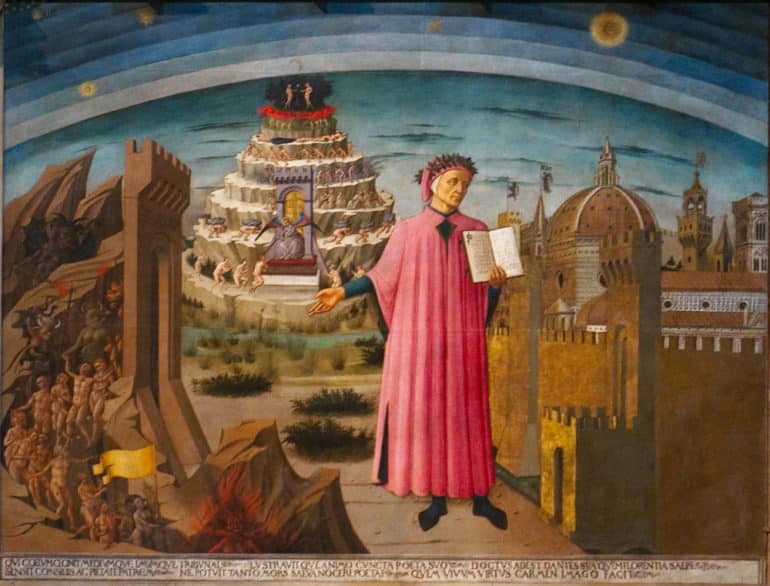The 14th-century Italian poet Dante Alighieri couldn’t have foreseen contemporary forms of hideous, malicious behavior—the Holocaust, the trans-Atlantic slave trade, genocide committed by ISIS.
Yet, Dante’s nearly 700-year-old, three-part epic poem, the Divine Comedy—of which “Inferno” is the initial part—remains an influential piece of literature in exploring the origins of evil.

Dante’s work has influenced or inspired music, novels, films, mobile apps, and even video games. Medieval manuscript illuminators and artists, including Sandro Botticelli and Salvador Dalí, have produced paintings mirroring stories Dante told. Most recently, Dante’s work was adapted for the crime and mystery film Inferno, starring Tom Hanks.
“When you have an actor like Tom Hanks starring in a movie adapted from best-selling novelist Dan Brown, you’re bound to get more questions about Dante than usual,” says Fabian Alfie, a professor in the University of Arizona department of French and Italian.
“But interest in Dante has never waned in the 700 years since he died,” Alfie says. “There is an unbroken tradition of Dante’s influence in Western culture since the 14th century. Dante has never stopped being popular because his poem deals with questions that are always relevant.”
Ultimately, Alfie says, Dante was attempting to address the “big questions” associated with being: “What is evil? What is human nature? What is redemption, goodness, sanctity?”
In light of the current attention paid to Dante’s “Inferno,” Alfie answered some questions:
How accurately does Inferno, starring Tom Hanks, depict Dante’s work?
Let me say up front that it’s not a reinterpretation of Dante’s work, or a fictionalization of Dante’s life, but a modern-day thriller.
Having said that, I was particularly impressed with the hallucinations seen by Robert Langdon, Tom Hanks’ character. Some of them were based on the punishments described in Dante’s hell, and they were shocking and frightening. Some of the characters also spoke about Dante’s biography, and it was reasonably accurate, if romanticized. But that’s a minor flaw in the grand scheme of things.
What is the value of film interpretations of classical work?
Adaptations of Dante help maintain interest in his work among the public. And it’s interesting to see how other artists reinterpret the work. How do they update it for the contemporary world? There are portions of Dante’s work that are now out of date. People in the Middle Ages were really preoccupied with usury and heresy, for instance. Nowadays, those sins aren’t much of a concern.
Conversely, Dante couldn’t include forms of evil like genocide in his hell because that’s a modern-day invention. Yet the concept of a hell organized around a classification of types of evil is still very seductive.
I could also talk about musical composers like Franz Liszt and Tchaikovsky, who’ve set the Divine Comedy to music. And there are far too many writers, literary critics, and commentators to mention.
What more can we learn/gain from work that, in this case, is more than 700 years old? In what ways, then, are the messages timeless that Dante advanced?
In the Divine Comedy, Dante tackles the big questions. The first portion, “Inferno,” is about categorizing and understanding the forms of human evil in all its forms, from the banal to the depraved. “Inferno” doesn’t merely represent an eternal torture chamber. It is, really, a meditation on evil.
Dante approaches the question of evil from the perspective of a medieval Christian, but the question is relevant no matter your religion. You have only to pay attention to the world around you to start wondering about evil behaviors, both great and minor.
The middle portion, “Purgatorio,” really explores human nature, and the ways we can transcend our fallen state, how we can overcome our human weaknesses.
And the last portion, “Paradiso,” is about goodness. It’s all couched as a literal journey through the Christian afterlife. “Paradiso” deals with transcendence, redemption, and virtue. But it’s the “Inferno” that has the greatest appeal in the contemporary world.
Sadly, I think cultural and historical events in the past few decades have made it easier for us to conceive of hell than it is to conceive of paradise.
What influence did Dante have on the Reformation? And how has he sustained such popularity?
I should be clear that Dante lived two centuries before the start of the Protestant Reformation, from 1265 to 1321. That said, in the Divine Comedy, Dante decried the corruption of the Catholic Church of his times: the economic decadence of simony, money-grubbing religious orders, sexual misdeeds of the clergy, the political machinations of the papacy, and the non-Christian actions they engaged in. So, in many ways, Dante was a reformer in line with the spirit of 16th-century Protestants.
Indeed, in 17th-century England, some writers talked about Dante as a de facto Protestant, employing him in their anti-Catholic propaganda. It was wholly inaccurate and terribly anachronistic, of course, but it had some foundations in Dante’s work.
Dante was interested in exploring the universal truths, as he understood them, but the vehicle he chose to do so is extremely specific. Most classical epic poems deal with the actions of a great hero from the historical past. The protagonist of the Divine Comedy, conversely, is Dante himself, set in 1300, the year he turned 35. Throughout the poem, he refers to his own family, other works he had written, and autobiographical experiences.
In “Inferno,” for instance, it is not a faceless everyman who takes a mystical journey through hell, but a specific individual, with friends, enemies, and a unique history. On the way, he meets real, historical individuals and not vague abstractions crafted merely to exemplify a specific sin.
Similarly, the entire underworld has a gripping topography, which exemplifies the organization of the sins. At the same time, it also makes the work vivid and easy to read. Because of the conical structure of hell, at no time does the reader lose track of where Dante is in his descent through human evil.
Source: University of Arizona

